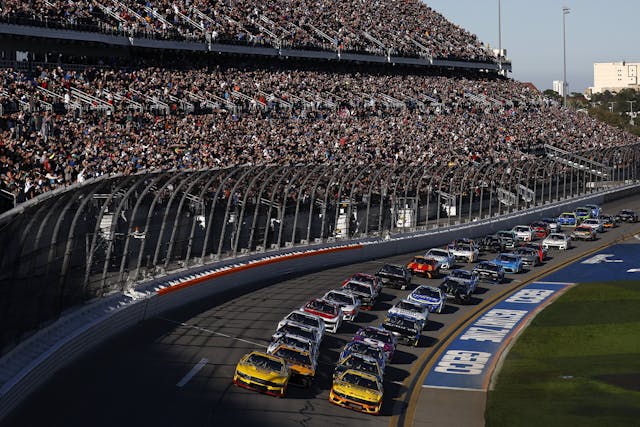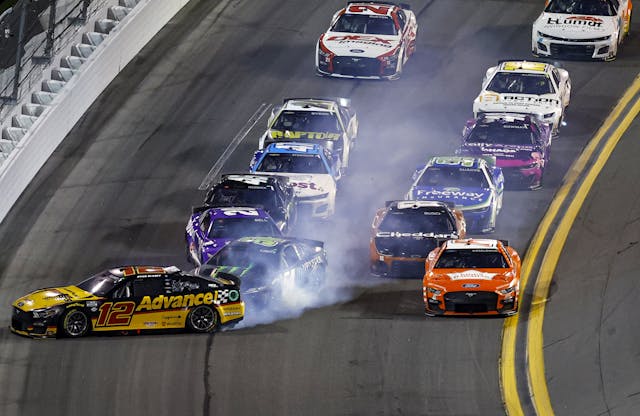Media | Articles
The Lawsuit Against NASCAR Is Flawed and, As You’d Expect, All About Money
In this corner: Beloved NBA legend Michael Jordan, and NASCAR driver Denny Hamlin.
In that corner: NASCAR chairman and CEO Jim France, 79-year-old (and turning 80 in two weeks) son of “Big Bill” France, the founder of NASCAR.
The lawsuit: Over money. Ain’t it always?
In an admittedly oversimplified nutshell: Jordan and Hamlin co-own 23XI Racing, along with investor Curtis Polk, which fields Toyota NASCAR Cup cars for Bubba Wallace and Tyler Reddick. (Hamlin still drives for Joe Gibbs Racing.) 23XI, along with Front Row Motorsports (Ford drivers are Michael McDowell, in his last season for the team, and David Gilliland), are suing NASCAR and Jim France in part over their dissatisfaction with the NASCAR charter system. NASCAR has asked teams to sign on for seven more years of the charter system, and all did, except for 23XI and Front Row. The two teams also want to expose, and presumably overturn, what they perceive to be an illegal monopoly in how NASCAR is run.
The suit accuses NASCAR of having “unlawfully exercised [monopoly] power in the market for premier stock car racing teams in the United States,” in violation of the Sherman Antitrust Act.
Marketplace
Buy and sell classics with confidence
NASCAR, the suit says, is using that monopoly power “to exclude competition and injure plaintiffs and other stock car racing teams by forcing them to simultaneously accept anticompetitive contract terms.” The suit asks for an injunction against NASCAR. If granted by the court, 23IX and Front Row would be allowed to get charters, apparently without having to sign NASCAR’s required agreement. Refusal of an injunction would cost the plaintiffs “tens of millions of dollars per year, which threatens the very existence of their businesses.”
In an even smaller nutshell, the charter system was created largely in response to team owners complaining that, after decades of participation in NASCAR, their teams only had value in the sense that they had cars and parts and facilities they could sell. In other sports—and you’ll be reading “in other sports” a lot as this lawsuit moves forward—the owner of, say, the Kansas City Chiefs could sell the team for far, far more than the face value of the players and a stadium.

NASCAR owners wanted something like that to sell, too. So in 2016, NASCAR created the charter system. It worked like this: NASCAR would offer 36 charters to the existing teams, representing one car per charter. Owning a charter would mean that the car would be guaranteed a starting spot in every race, without having to qualify. That meant that the team owner could sell sponsorship with guaranteed exposure on track for every race. It also meant that the car would earn the maximum share of the purse, depending on finishing position.
It would be good for TV ratings and attendance, since fan favorites like Jimmie Johnson and Dale Earnhardt, Jr. would never be in danger of not qualifying, and being parked for a race. Dale Jr. fans could buy a ticket and know for sure they’d see him race.

Since NASCAR races are capped at 40 starting positions, the charter system left four “open” spots that non-chartered teams could try to qualify for. Those positions have most often been filled by lower-budget or part-time teams, based on their qualifying speed. Seldom, though, do more than 40 cars show up for a race nowadays, so everybody who wants to race, does.
The charters, which reportedly sold for several million originally, would, NASCAR figured, go up in value on the open market. They have, by roughly tenfold or more. If a team owner holds two charters (each owner is allowed a maximum of four) and wants to sell one, the owner takes offers from buyers, and typically accepts the highest one.
Thus solved, at least to NASCAR’s thinking, the problem that team owners complained about—wanting more to sell than just the store and its employees. A few weeks ago, IndyCar adopted essentially the same system.
Including an extension granted in 2020, the charters granted by the original agreement with NASCAR run through 2024. Recently, the series had the team owners sign up for a new agreement to secure charters that would last another seven years. There were multiple details in the new charter agreement that team owners didn’t like: They wanted the agreement to be permanent, first off, rather than a seven-year agreement. They also didn’t like the fact that NASCAR would be able to buy back charters if it wanted to, presumably allowing the sanctioning body to field cars itself, though that idea seems far-fetched. Team owners grumbled but signed what was termed NASCAR’s “final offer.” Only 23XI and Front Row balked.

And that’s how the NASCAR charter system works—or doesn’t work, if you’re 23XI and Front Row. (I know it’s complicated: KickintheTires.net and Sportsnaut.com have posted good information on the suit.) Both 23XI and Front Row have indicated that, if they have to, they might run as “open,” non-chartered teams next year. Which could leave six charters all of a sudden unspoken for: Presumably, if they aren’t sold, there would be 10 starting spots instead of four available to open, non-chartered teams. Of course, that could change. It’s still NASCAR’s world, and the teams are just living in it.
Here’s my analysis, for what it’s worth: The argument the lawsuit presents, as mentioned, leans heavily on what other sports do. Let’s establish that NASCAR is not “other sports,” and never will be: It is simply that much different from basketball, baseball, football, soccer—pick one.
In his last year playing for the Chicago Bulls, Michael Jordan was paid $33,000,000 in 1997 dollars. That kind of money simply doesn’t exist in NASCAR, especially in this tough sponsorship environment. And in 2016, NASCAR quit reporting how much drivers earn in purse money, and it wasn’t because the purses were going up. (NASCAR’s explanation for ending its 60-year tradition of publishing race winnings was because the practice wasn’t “contemporary,” given the new charter system.)
Here’s why the lawsuit is flawed:
• In its 76-year history, NASCAR has made hundreds, maybe thousands, of participants rich. Not Michael Jordan rich, but inflation-adjusted millionaires, anyway. If you don’t feel you are getting compensated fairly, quit. Participation in stock car racing is strictly voluntary.
• It is hard to argue that the current France-family leadership team—Jim as CEO and chairman, niece Lesa France Kennedy as executive vice chair of NASCAR, and her son Ben Kennedy, NASCAR’s executive vice president—haven’t delivered. They’ve moved quickly to solve problems when they arise; they have invested in the sport; they have surrounded themselves with competent executives such as NASCAR president Steve Phelps and NASCAR chairperson Mike Helton; the venues owned by NASCAR lack for nothing; Jim France has overseen IMSA sports car racing, and it’s better than ever; he has propped up the NASCAR Craftsman truck series and the recently acquired ARCA feeder series in the interests of competition and developing future talent. The forward-looking 2025–2031 NASCAR broadcast contract will bring in more than $1 billion per year. Finally, no future star has participated in NASCAR and then migrated to a different sanctioning body in years.
• Why haven’t they? Money—and there’s still a lot available, one reason being that NASCAR has a 33-race schedule, far more than other major U.S.-based series. According to the original 157-page court filing, Front Row owner Bob Jenkins said that despite being in existence for 20 years, Front Row, which currently has 80 employees, has never made a profit. Why does he keep coming back? If he has been running the team out of his pocket for 20 years, NASCAR is more of a sport than a business to him.
• If 23IX and Front Row want to create and back a competing series, they should do it. If not, play by the rules you signed up for. If the teams’ revenue is indeed “tens of millions of dollars per year,” it will be difficult to argue that NASCAR participation resulted in poverty conditions.
• Central in the lawsuit filing is a request to essentially open NASCAR’s books to the public. Fine, if it was a public company; but it’s a private company, and as such doesn’t have to make its finances public. There have been suggestions that this threat could result in NASCAR writing a massive go-away check to 23XI and Front Row. Those making that suggestion don’t know Jim France.
The France family built NASCAR. Let them keep operating it as they see fit. If you don’t like it, take your ball and find another playground.















As usual, there is a whole lot more to the tale that none of us will ever know. First off, the France family are enthusiasts, they do what they think is right to maintain and grow the sport. If they weren’t they’d just sell off NASCAR, keep the tracks they own deal with the politics. Having said that, my own experience with them during the Roger Edmonston years and MOTO-ST is that they aren’t afraid to take chances and sometimes fail. They run American Flat Track racing now, and it’s seems to be stalled in the chute. What should they do ? IMHO, simplify and shorten the NASCAR season, lose the phony yellows and continue to refine the cars. Say what you like about IndyCar being a one make series, the racing is way better than Formula One.